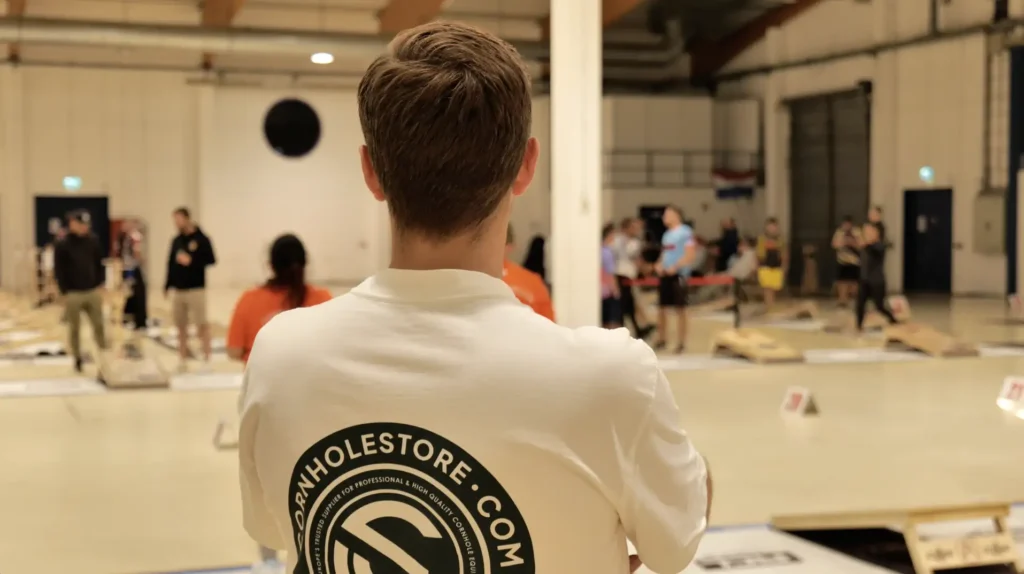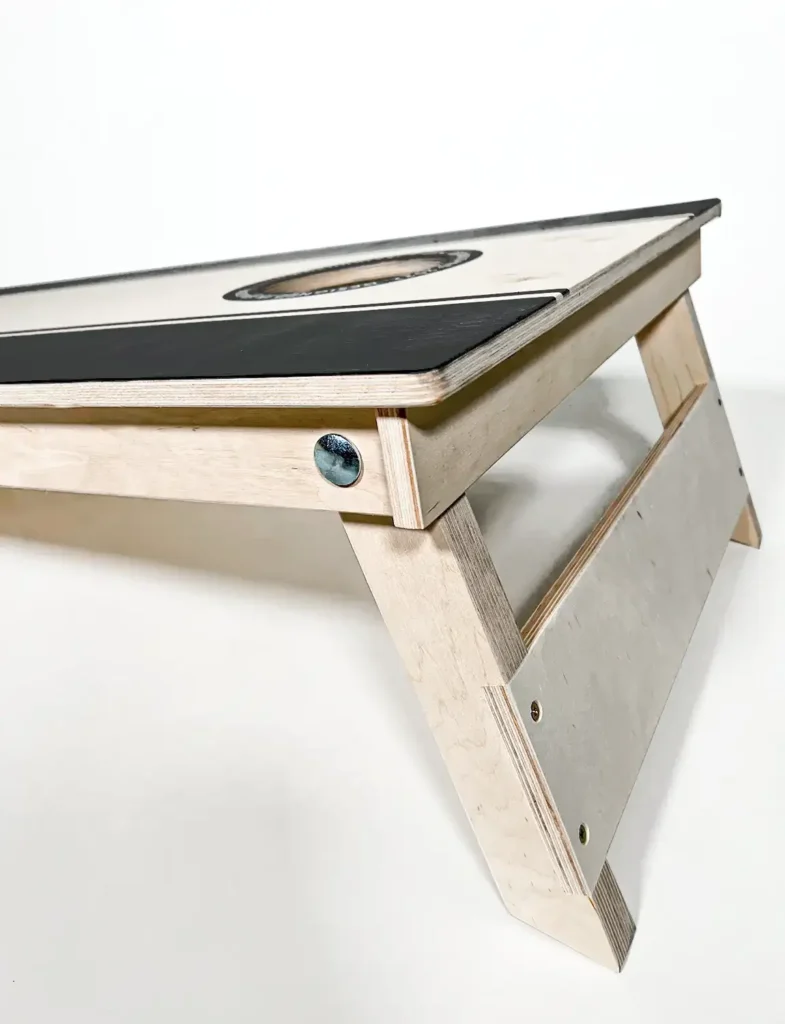How to organize a Cornhole Tournament (Guide 2025)
-
Published by: Anton Gustafsson
- Last updated:

Cornhole has rapidly gained popularity as both a casual backyard game and a competitive sport. Organizing a cornhole tournament is a great way to bring people together for some fun, competition, and camaraderie.
Whether you’re planning a small family gathering or a large-scale charity event, hosting a successful cornhole tournament requires careful planning and attention to detail.
In this guide, we’ll cover everything you need to know to organize a cornhole tournament that runs smoothly and keeps everyone engaged—from setting up the venue and structuring the event to managing brackets and ensuring a great experience for all participants.
Table of Contents
- Define the Purpose and Scope of Your Tournament
- Planning the Tournament Logistics
- Selecting the Tournament Format
- Setting Up the Venue
- Managing Teams and Registration
- Building and Running a Tournament Bracket
- Additional Considerations: Prizes, Rules, and Food
- Promoting the Cornhole Tournament
- Conclusion
Define the Purpose and Scope of Your Tournament
Before diving into logistics, it’s important to clarify the purpose of your cornhole tournament. Understanding your goals will help shape the event and determine key decisions such as venue, format, and scale.
Questions to Consider:
- Is this a charity or fundraising event? If so, consider including donation components or raffles.
- Will the tournament be casual or competitive? A casual tournament might have looser rules, while a competitive one may require regulation equipment and adherence to official guidelines.
- How many participants are you expecting? The number of teams will determine how many boards you need and the type of bracket system to use.
Once you’ve defined the purpose, you can proceed to logistical planning.

I visited Europe’s largest ever cornhole turning to see how it works to organize such a large competition. This competition was organized by ACL Europe and took place in Trier, Germany.
Planning the Tournament Logistics
1. Date and Time
Choosing the right date and time is crucial. If it’s a small, casual event, a Saturday afternoon might work perfectly. For larger events, consider the availability of participants, potential competing events, and the time of year. Outdoor tournaments should account for weather conditions, so having a backup indoor venue or a rain date might be wise.
2. Duration of the Tournament
Depending on the number of participants and format, a cornhole tournament can take anywhere from a few hours to an entire day. Plan accordingly, and make sure to communicate the estimated timeline to all participants.
3. Location
The venue is a key factor in how smoothly your tournament runs. Choose a space that accommodates the number of boards you need, allows for spectators, and offers enough room for participants to move around. Popular venue options include:
- Parks: Perfect for outdoor summer events.
- Community Centers: Ideal for indoor tournaments.
- Sports Facilities: If available, a gym or arena provides ample space.
Selecting the Tournament Format
The format you choose will determine how games are played, how long the tournament lasts, and how winners are decided. Here are some common formats:
| Format | Description |
|---|---|
| Single Elimination | Teams are eliminated after one loss. Quick and efficient but doesn’t guarantee a lot of play time. |
| Double Elimination | Teams must lose twice to be eliminated, offering more play time but taking longer. |
| Round Robin | Every team plays against every other team. Ideal for smaller tournaments. |
| Pool Play | Teams are divided into smaller groups, playing each team in their pool. Top teams advance to a knockout stage. |
| Blind Draw | Partners are randomly paired for each game, adding a social element. |
How to Choose the Right Format:
- Single or Double Elimination: Best for competitive tournaments with a large number of teams.
- Round Robin: Works well for casual or smaller events where you want everyone to play multiple games.
- Pool Play: Great for large events where you want to ensure fair play among all teams.
- Blind Draw: Fun for social or fundraising events where mixing teams and participants is part of the fun.
Setting Up the Venue
Your tournament’s success heavily depends on the organization of the venue. Here’s a checklist to ensure everything is in place:
1. Cornhole Boards and Bags
You’ll need enough cornhole boards to keep the tournament moving efficiently. For example, if you have 20 teams, having at least 5 to 8 boards will help speed things up.
2. Measuring and Marking the Distance
Make sure the boards are properly spaced. The regulation distance between cornhole boards is 27 feet from front to front. Mark this distance with tape or cones to maintain consistency throughout the tournament.
3. Spectator and Player Areas
Designate areas for players waiting for their turn and for spectators to watch the games. Seating or shaded areas, especially for outdoor events, can help keep everyone comfortable.
4. Sound System and Announcements
Having a microphone or PA system will make it easier to announce matchups, scores, and updates, especially if the event is large.
Managing Teams and Registration
1. Pre-Registration
Pre-registration helps you gauge the number of participants, allocate resources, and build a schedule. You can use online registration platforms like Eventbrite or Google Forms to collect participant information and fees.
| Information to Collect During Registration: |
|---|
| Player names |
| Team names |
| Contact information |
| Payment (if applicable) |
2. On-Site Registration
For larger tournaments, you may need on-site registration or check-in. Set up a registration table with clear signage, where participants can check in, pay fees (if applicable), and receive any necessary materials, such as name tags, wristbands, or tournament brackets.
3. Team Sizes
Cornhole is typically played in teams of two, but depending on your format, you may allow singles or rotate players on larger teams. Make sure to clearly communicate the team size rules before registration.
Building and Running a Tournament Bracket
Once you know how many teams will participate, it’s time to create the bracket. You can either manually create the bracket or use one of the many online tools, such as Challonge or BracketHQ, to simplify the process. You can also use white board brackets like these.
1. Seeding Teams
You may want to seed teams based on skill level, especially if you know the participants or if it’s a competitive event. This ensures the top teams don’t face each other in early rounds. For casual tournaments, randomizing the bracket is a fair and fun option.
2. Tracking Scores
Make sure to assign volunteers or referees to keep track of scores and update the bracket after each game. Designate a central scoreboard or online platform to display live results and upcoming matchups.
3. Scheduling Matches
Carefully plan the timing of matches, especially if you’re using a format like double elimination that may require multiple games. Communicate the schedule clearly to all participants, and have a system in place to call teams to the boards when it’s their turn.
Additional Considerations: Prizes, Rules, and Food
1. Prizes
Offering prizes is a great way to add excitement to your tournament. Prizes can range from trophies and medals to gift cards or even cash for the winners.
| Prize Ideas: |
|---|
| Trophies or medals |
| Cornhole gear (boards, bags) |
| Gift cards (restaurants, stores) |
| Cash prizes (for larger or competitive events) |
2. Tournament Rules
Set clear rules before the tournament starts. This should include cornhole regulations (bag weight, board size, and distance) as well as game format rules. If you’re hosting a competitive event, consider using ACL (American Cornhole League) or ACO (American Cornhole Organization) regulations to maintain consistency.
| Key Rules to Consider: |
|---|
| Regulation board and bag sizes |
| Scoring rules (cancellation scoring, etc.) |
| Foul lines and foot faults |
| Timing rules (shot clock, match time limit) |
3. Food and Drink
Providing food and drinks can turn your tournament into a fun, full-day event. Consider hiring food trucks, setting up a snack table, or even offering a BBQ for outdoor events. If the tournament is a fundraiser, selling food and drinks is a great way to raise additional money.
Promoting the Cornhole Tournament
If your tournament is open to the public, it’s important to promote it well in advance. Use the following methods to get the word out:
1. Social Media
Create an event page on Facebook, Instagram, and other platforms to share details, updates, and registration links. Encourage participants to share the event with friends.
2. Flyers and Posters
Post flyers in local community centers, gyms, schools, and sports clubs. Include essential information like date, time, location, and how to register.
3. Email Marketing
If you’re part of a larger organization or community group, send out an email blast to your members or subscribers.
Conclusion
Organizing a cornhole tournament can be a fun and rewarding experience. Whether it’s a small, casual gathering or a large, competitive event, careful planning and attention to detail are key to ensuring everything runs smoothly.
By following the steps outlined in this guide, you can host a cornhole tournament that participants will remember for years to come.
From selecting the right format to managing teams and registration, to ensuring everyone has a great time, each step plays a critical role in the tournament’s success. So, gather your cornhole boards, recruit some teams, and get ready for an exciting day of cornhole competition!
Buy your cornhole game with us at Cornholestore!
Order our complete cornhole games with high-quality boards and bags in any color.
- Made in Europe's leading cornhole factory
- Trendy Scandinavian design
- Pay safely with Klarna

